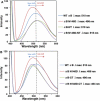Structural and functional roles of deamidation of N146 and/or truncation of NH2- or COOH-termini in human αB-crystallin
- PMID: 21976952
- PMCID: PMC3185027
Structural and functional roles of deamidation of N146 and/or truncation of NH2- or COOH-termini in human αB-crystallin
Abstract
Purpose: The purpose of the study was to determine the relative effects of deamidation and/or truncation on the structural and functional properties of αB-crystallin.
Methods: Using wild-type (WT) αB-crystallin and the αB deamidated mutant (i.e., αB N146D), we generated NH(2)-terminal domain deleted (residues no. 1-66; αB-NT), deamidated plus NH(2)-terminal domain deleted (αB N146D-NT), COOH-terminal extension deleted (residues no. 151-175; αB-CT), and deamidated plus COOH-terminal extension deleted (αB N146D-CT) mutants. All of the proteins were purified and their structural and functional (chaperone activity with insulin as target protein) properties were determined and compared to WT αB-crystallin.
Results: The desired deletions in the αB-crystallin mutants were confirmed by DNA sequencing and matrix-assisted laser desorption/ionization time-of-flight (MALDI-TOF) mass spectrometric analysis. The homomers of αB-CT and its deamidated form (αB N146D-CT) became water insoluble, whereas the αB N146D, αB-NT, and αB N146D-NT species remained water-soluble. CD spectroscopic studies revealed that the mutants with deletion of NH(2)- or COOH-termini or deamidation showed increased β-sheet and decreased α-helical contents with the exception of αB N146D-CT, which showed a substantial increase in α-helix and decrease in β-sheet content. Results of intrinsic Trp fluorescence suggested little change in Trp microenvironment of αB N146D relative to WT αB, but substantial alterations on deletion of COOH-terminal extension or a combination of this deletion plus deamidation. Hydrophobic binding studies using the hydrophobic probe 8-anilino-1-naphthalene sulfonate (ANS) showed that, relative to WT αB structure, the N146 deamidation, COOH-terminal extension deletion or a combination of this deamidation and deletion resulted in a relatively compact structure whereas the NH(2)-terminal domain deletion and a combination of this deletion plus deamidation resulted in a relaxed structure. All the αB mutants showed higher molecular mass ranging between 1.2×10(6) to 5.4×10(6) Da, relative to WT αB which had a molecular mass of 5.8×10(5) Da. Chaperone activity across all αB species decreased in the following order: WTαB > αB N146D-CT > αB N146D-NT > αB-NT > αB-CT > αB N146D. Specifically, substantial losses in chaperone activity (only 10% to 20% protection) were seen in αB N146D, αB-NT, and αB-CT. However, in the species with the combination of deamidation plus NH(2)- or COOH-terminal deletion, the percent protection was about 24% in αB N146D-NT and about 40% in αB N146D-CT.
Conclusions: Although all mutants formed oligomers even after deamidation, on deletion of either NH(2)-terminal domain or COOH-terminal extension or a combination of these deletions and deamidation, their structural properties were substantially altered. The results suggested that the NH(2)-terminal domain is relatively more important than the COOH-terminal extension for the chaperone function of αB. The non-deamidated N146 residue, NH(2)-terminal domain and COOH-terminal extension are also of critical importance to the maintenance of αB-crystallin chaperone activity.
Figures






Similar articles
-
Structural and functional roles of deamidation and/or truncation of N- or C-termini in human alpha A-crystallin.Biochemistry. 2008 Sep 23;47(38):10069-83. doi: 10.1021/bi8001902. Epub 2008 Aug 29. Biochemistry. 2008. PMID: 18754677
-
Effect of deamidation of asparagine 146 on functional and structural properties of human lens alphaB-crystallin.Invest Ophthalmol Vis Sci. 2004 Jan;45(1):206-14. doi: 10.1167/iovs.03-0720. Invest Ophthalmol Vis Sci. 2004. PMID: 14691175
-
Deamidation affects structural and functional properties of human alphaA-crystallin and its oligomerization with alphaB-crystallin.J Biol Chem. 2004 Oct 22;279(43):44258-69. doi: 10.1074/jbc.M405648200. Epub 2004 Jul 28. J Biol Chem. 2004. PMID: 15284238
-
Functional sequences in human alphaB crystallin.Biochim Biophys Acta. 2016 Jan;1860(1 Pt B):240-5. doi: 10.1016/j.bbagen.2015.08.014. Epub 2015 Sep 2. Biochim Biophys Acta. 2016. PMID: 26341790 Free PMC article. Review.
-
The multifaceted nature of αB-crystallin.Cell Stress Chaperones. 2020 Jul;25(4):639-654. doi: 10.1007/s12192-020-01098-w. Epub 2020 May 7. Cell Stress Chaperones. 2020. PMID: 32383140 Free PMC article. Review.
Cited by
-
Streamlined Multi-Attribute Assessment of an Array of Clinical-Stage Antibodies: Relationship Between Degradation and Stability.Appl Spectrosc. 2024 Feb 29;79(1):37028241231824. doi: 10.1177/00037028241231824. Online ahead of print. Appl Spectrosc. 2024. PMID: 38419510 Free PMC article.
-
The functional roles of the unstructured N- and C-terminal regions in αB-crystallin and other mammalian small heat-shock proteins.Cell Stress Chaperones. 2017 Jul;22(4):627-638. doi: 10.1007/s12192-017-0789-6. Epub 2017 Apr 8. Cell Stress Chaperones. 2017. PMID: 28391594 Free PMC article.
-
Post-translationally modified human lens crystallin fragments show aggregation in vitro.Biochem Biophys Rep. 2017 Feb 20;10:94-131. doi: 10.1016/j.bbrep.2017.01.011. eCollection 2017 Jul. Biochem Biophys Rep. 2017. PMID: 28955739 Free PMC article.
-
Small molecules, both dietary and endogenous, influence the onset of lens cataracts.Exp Eye Res. 2017 Mar;156:87-94. doi: 10.1016/j.exer.2016.03.024. Epub 2016 Mar 31. Exp Eye Res. 2017. PMID: 27039707 Free PMC article. Review.
-
Degradation of an old human protein: age-dependent cleavage of γS-crystallin generates a peptide that binds to cell membranes.J Biol Chem. 2012 Nov 9;287(46):39012-20. doi: 10.1074/jbc.M112.391565. Epub 2012 Sep 20. J Biol Chem. 2012. PMID: 22995907 Free PMC article.
References
-
- Bloemendal H, de Jong WW, Jaenicke R, Lubsen NH, Slingsby C, Tardieu A. Ageing and vision: structure, stability and function of lens crystallins. Prog Biophys Mol Biol. 2004;86:407–85. - PubMed
-
- Andley UP. Crystallins in the eye: function and pathology. Prog Retin Eye Res. 2007;26:78–98. - PubMed
-
- Bhat SP, Nagineni CN. αB subunit of lens-specific protein α-crystallin is present in other ocular and non-ocular tissues. Biochem Biophys Res Commun. 1989;158:319–25. - PubMed
-
- de Jong WW, Caspers GJ, Leunissen JA. Genealogy of the alpha-crystallin-small heat-shock protein superfamily. Int J Biol Macromol. 1998;22:151–62. - PubMed
Publication types
MeSH terms
Substances
Grants and funding
LinkOut - more resources
Full Text Sources
Research Materials
